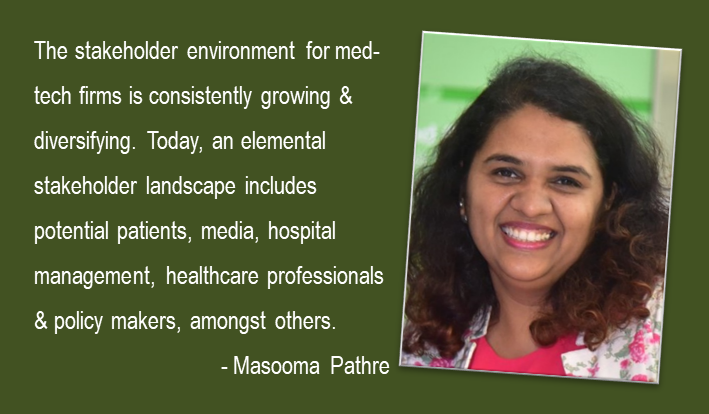The role of communications over the past decade and specially in the pandemic has seen a renewed emergence in the corporate world. We have witnessed increased adoption of digital tools, heightened focus on internal communications and employee engagement, and revived attention towards brand building and reputation management. Within the med-tech industry as well, several challenges in the form of regulations, complex stakeholder networks, and an increased need to raise awareness about health conditions and therapies, have pushed for the adoption of a more holistic communications strategy.
In light of these changes, communication roles have evolved to effectively cater to industry requirements beyond pure marketing communications, product launches and digital/social media marketing
Effective stakeholder engagement
The stakeholder environment for med-tech firms is consistently growing and diversifying. Today, an elemental stakeholder landscape includes potential patients, media, hospital management healthcare professionals and policymakers amongst others. With varied stakeholders, targeted messaging is a must but one should also factor in several additional considerations, such as how the message will be perceived, whether it is within regulatory guidelines or how it might affect the company’s reputation.
Likewise, the healthcare media plays a crucial role in disseminating health information- affecting the knowledge and health beliefs of the public at large. In such a scenario, an external communications strategy must reflect an attempt at educating and promoting balanced reporting by arming journalists with reliable health statistics and data, understanding of specific therapies and knowledge of medical terminology.
Another facet of stakeholder engagement is thought leadership. It plays a crucial role in bridging the knowledge gap between the brand and its audience. Professional standards and expectations for credibility in healthcare have elevated considerably and thus the thought leadership messaging is not about recycling an old message; it is about bringing value, collaborating, and delivering quality healthcare solutions and patient benefits
Crafting communication narratives for a med-tech thought leader therefore also depends on identifying a key communication goal. This could be in the form of advocacy that addresses access to healthcare, or even awareness of therapy areas. Similarly, it could also be illustrated through a focus on innovation through product, procedure, or health systems.
For a med-tech company, collaboration with government and industry bodies to advance healthcare is an important aspect. Thus, the narrative is data driven and focuses on calling out the need in terms of diseases, therapy awareness and need of the healthcare infrastructure. The second aspect is calling out the company’s efforts to educate, train and energise the ecosystem. For instance, a communication narrative would focus on advancement of technology, training and education, manufacturing or research and development that specifically supports the healthcare need of the country.
Advocacy— the cornerstone of all communication
Medical technology marketing has traditionally been focused on healthcare practitioners or physicians. However, with access to vast online resources, patients are now fitting more and more into the role of a customer. While the internet and social media can provide a wealth of information for patients, it is also possible for incorrect or incomplete information to be published online, which can put them at risk.
As such, med-tech companies must position themselves as advocates for health and push out key narratives focused on the promotion of health and health care delivery. These narratives accordingly would form a key part of a med-tech organisation’s role as an advocate that addresses prevalent capacity and awareness barriers. This kind of communication helps instill trust between a brand and its customers, demonstrate value, and differentiates itself from the competition. Publishing results of clinical trials, relevant infographics and information on therapy and disease areas can build credibility, helping companies become a trusted source of information with current or future patients. Such efforts, also prove instrumental in patients becoming advocates for the technology or therapy in that they lend credibility to the advocacy. Yet again while doing this, one important aspect to keep in mind is the regulatory and compliance framework of a country.
Internal communication—a critical asset
For a medical technology organisation, the sales force is a vital component in business strategy. Sales staff must be significantly skilled, have knowledge of compliance and regulatory measures, and tackle longer selling cycles and complex stakeholder networks. In such a scenario, internal communications play a sizeable role in building rapport between employees, providing an outlet to voice challenges, highlight performance, and ensuring timely recognition of the efforts of the sales force.
However, the role of a communication department does not end there. In an increasingly regulated and sensitive environment, overarching narratives of quality and compliance must be reiterated across all divisions of the organisation. Hence, the communications team works closely with HR and marketing functions, to ensure that the right messaging is incorporated in all internal as well as external campaigns.
The industry will continue to see the birth of several micro-trends across the industrial and consumer landscape. It is therefore going to be incumbent upon corporate communications professionals to rally the forces, collaborate, and continue to tell the very positive story of the value that medical technology companies deliver to all stakeholders.
The views and opinions published here belong to the author and do not necessarily reflect the views and opinions of the publisher.



Be the first to comment on "Cultivating value-based communication in the med-tech sector"